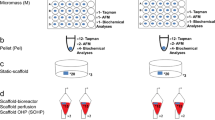Abstract
In the recent years, there has been considerable development in the regenerative medicine, which aims to repair, regenerate, and improve injured articular cartilage. The aim of the present study was to investigate the effect of flow-induced shear stress in perfusion bioreactor on alginate encapsulating chondrocytes. The shear stress imposed on the cells in the culture chamber of bioreactor was predicted with computational fluid dynamic. Bovine nasal chondrocytes were isolated and expanded to obtain a pellet. The cell pellet was resuspends in alginate solution, transferred to the culture chamber, and dynamically cultured under direct perfusion. At the end of culture, tissue constructs were examined histologically and by immunohistochemistry. The results of computational fluid dynamic modeling revealed that maximum wall shear stress was 4.820 × 10−3 Pascal. Macroscopic views of the alginate/chondrocyte beads suggested that it possessed constant shape but were flexible. Under inverted microscope, round shape of chondrocyte observed. Cell distribution was homogeneous throughout the scaffold. Tissue construct subjected to shear showed morphological features, which are characteristic for natural cartilage. Immunohistochemistry results revealed immunopositivity for type II collagens in tissue constructs samples. Flow induced shear stress in the perfusion bioreactor and chnondrocyte encapsulation provide environment to support cell growth, and tissue regeneration and improve cartilage like tissue fabrication.






Similar content being viewed by others
References
Athanasiou KA, Darling EM, Hu JC (2009) Articular cartilage tissue engineering. Synth Lect Tissue Eng 1(1):1–182
Bittencourt RADC, Pereira HR, Felisbino SL, Ferreira RR, Guilherme GRB, Moroz A et al (2009) Chondrocyte cultures in tridimensional scaffold: alginate hydrogel. Acta Ortop Bras 17(4):242–246
Chen H-C, Hu Y-C (2006) Bioreactors for tissue engineering. Biotechnol Lett 28(18):1415–1423
Drury JL, Mooney DJ (2003) Hydrogels for tissue engineering: scaffold design variables and applications. Biomaterials 24(24):4337–4351
Gemmiti CV, Guldberg RE (2006) Fluid flow increases type II collagen deposition and tensile mechanical properties in bioreactor-grown tissue-engineered cartilage. Tissue Eng 12(3):469–479
Gharravi AM, Orazizadeh M, Ansari-Asl K, Banoni S, Izadi S, Hashemitabar M (2012) Design and fabrication of anatomical bioreactor systems containing alginate scaffolds for cartilage tissue engineering. Avicenna J Med Biotechnol 4(2):65
Gharravi AM, Orazizadeh M, Hashemitabar M (2014) Direct expansion of chondrocytes in a dynamic three dimensional culture system: overcoming dedifferentiation effects in monolayer culture. Artif Organs 38(12):1053–1058
Gharravi AM, Orazizadeh M, Hashemitabar M (2015) A novel culture chamber design and cell biomaterial sheet engineering for reconstruction of cartilage tissue. Int J Health Stud 1(1):20–23
Klein TJ, Malda J, Sah RL, Hutmacher DW (2009) Tissue engineering of articular cartilage with biomimetic zones. Tissue Eng Part B: Rev 15(2):143–157
Liao J, Guo X, Grande-Allen KJ, Kasper FK, Mikos AG (2010) Bioactive polymer/extracellular matrix scaffolds fabricated with a flow perfusion bioreactor for cartilage tissue engineering. Biomaterials 31(34):8911–8920
Luder HU, Leblond C, Von Der Mark K (1988) Cellular stages in cartilage formation as revealed by morphometry, radioautography and type II collagen immunostaining of the mandibular condyle from weanling rats. Am J Anat 182(3):197–214
Mahmoudifar N, Doran PM (2005) Tissue engineering of human cartilage in bioreactors using single and composite cell-seeded scaffolds. Biotechnol Bioeng 91(3):338–355
Martin I, Wendt D, Heberer M (2004) The role of bioreactors in tissue engineering. Trends Biotechnol 22(2):80–86
Ochi M, Adachi N, Nobuto H, Yanada S, Ito Y, Agung M (2004) Articular cartilage repair using tissue engineering technique—novel approach with minimally invasive procedure. Artif Organs 28(1):28–32
Raimondi MT, Moretti M, Cioffi M, Giordano C, Boschetti F, Laganà K et al (2006) The effect of hydrodynamic shear on 3D engineered chondrocyte systems subject to direct perfusion. Biorheology 43(3):215–222
Schulz RM, Bader A (2007) Cartilage tissue engineering and bioreactor systems for the cultivation and stimulation of chondrocytes. Eur Biophys J 36(4–5):539–568
Sheaff MT, Singh N (eds) (2013) Soft tissue and bone and joint cytology. In: Cytopathology. Springer, London, pp 423–451
Xu X, Urban JP, Tirlapur U, Wu MH, Cui Z, Cui Z (2006) Influence of perfusion on metabolism and matrix production by bovine articular chondrocytes in hydrogel scaffolds. Biotechnol Bioeng 93(6):1103–1111
Zhang L, Hu J, Athanasiou KA (2009) The role of tissue engineering in articular cartilage repair and regeneration. Crit Rev Biomed Eng 37(1–2):1–57
Author information
Authors and Affiliations
Corresponding author
Rights and permissions
About this article
Cite this article
Gharravi, A.M., Orazizadeh, M. & Hashemitabar, M. Fluid-induced low shear stress improves cartilage like tissue fabrication by encapsulating chondrocytes. Cell Tissue Bank 17, 117–122 (2016). https://doi.org/10.1007/s10561-015-9529-2
Received:
Accepted:
Published:
Issue Date:
DOI: https://doi.org/10.1007/s10561-015-9529-2




